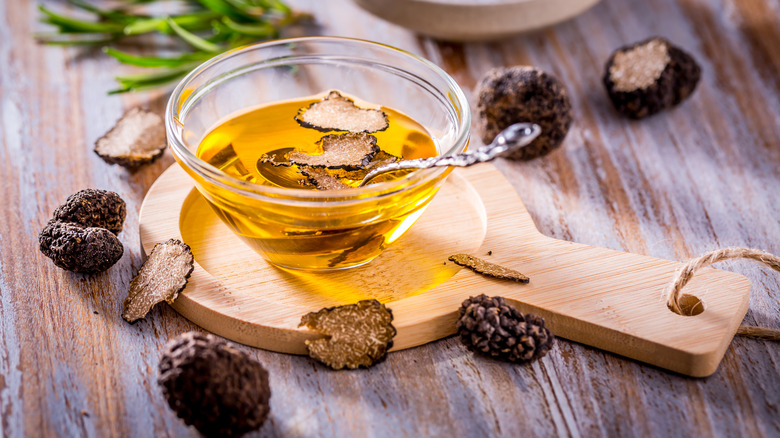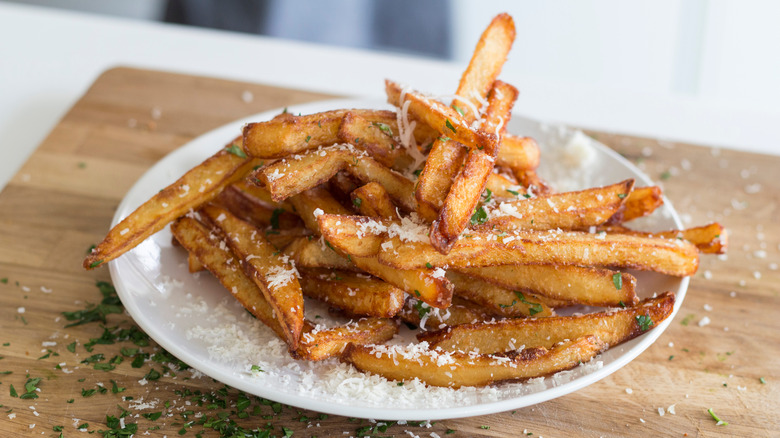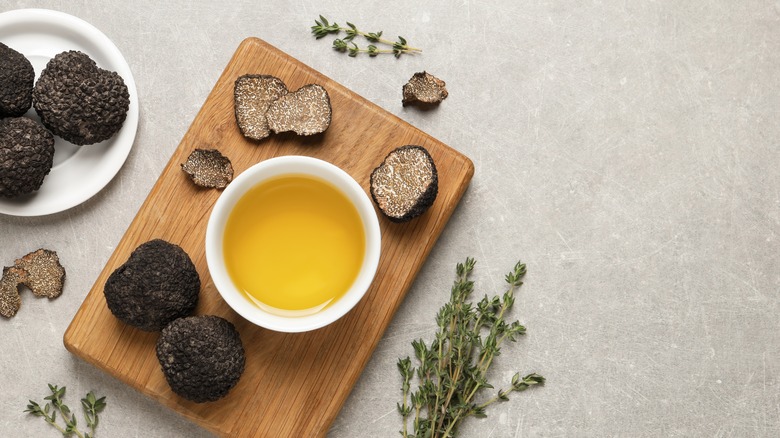Why It's Always A Mistake To Cook With Truffle Oil
Almost no ingredient remains as elusive (or as expensive) as black truffles, but truffle oil can give you a hint of the experience. Whether you're using it for truffle poached eggs over toast or recreating truffle fries from your favorite restaurant, real truffle oil can be delicious and is much more affordable than whole truffles, but it's certainly not cheap. Squandering the flavor of this luxury ingredient is the last thing you want to do in the kitchen.
Most of us immediately think of oils as a cooking medium, but using truffle oil in any step of the cooking process is one of the biggest mistakes home cooks can make. Truffles are incredibly sensitive to heat. When exposed to high temperatures for extended periods of time, the flavors and aromas diminish considerably, leaving you with a bland end result that will make you feel like you've wasted your money.
Truffle oils are no exception to this rule. Searing, sautéing, or even baking with authentic truffle oils will only make their earthy, umami flavor vanish into thin air. Don't treat this condiment the same way you'd treat a cooking oil — it's actually more like a garnish. Drizzle the oil over pasta, a pizza, risotto or, as previously mentioned, a side of garlic fries, to enjoy its flavor without destroying it. Complementary flavor pairings will also help you get the most out of this oil.
Simple flavors pair best with truffle oil
Truffle oils are best used in dishes where their flavor can stand out from the rest. Classic preparations with a truffle twist is the name of the game if you've never used this ingredient before. When paired with a creamy pasta or a perfectly-seared beef tenderloin, this condiment can easily give some personality to a simple dish that might otherwise seem pleasant but predictable in flavor. In fact, you can even use truffle oil as a simple salad dressing or bread dip — two ways for you to bring some life into appetizers that can be run-off-the-mill.
While you might now be tempted to spice up every future dish you make with a drizzle of truffle oil, have some restraint when incorporating this garnish into recipes. While truffles do have a potent taste, their flavor doesn't shine as well in an acidic or spicy dish. The tang of citrus or the spice of chili will compete with or even mask the flavor of your oil, which is dark and earthy. You could end up with a dish that lacks the musky overtones of truffles or tastes dissonant in its flavor profile. A confusing taste is likely not what you want from your dinner, so be picky when drizzling truffle oil — you'll get the most out of its flavor and the money you spent on it.
More tips for using truffle oil
Nobody can deny that the complex flavor of truffle oil borders on being addictive. While you might be tempted to drizzle copious amounts of it on every dish you make after purchasing it, you really should be conservative when using it. Adding too much truffle oil will suffocate the rest of the flavors of your food, resulting in a dish that feels unbalanced or even over-seasoned. Treat truffle oil like a cologne — too much, and its potency will turn you or your guests off from its delectable flavors. A few drops or a teaspoon should be more than enough to give your food the kick that it needs to become memorable.
As a final note, there's an elephant in the room regarding truffle oil: many brands don't actually contain any real truffles. Most "truffle" oils are merely flavored using a chemical called 2,4-dithiapentane. Before you even think about ways to use this ingredient, look for a brand that uses genuine truffles (and be prepared to pay more for the authentic stuff). All you have to do is examine the ingredients list and pass on any bottles that don't list black truffles. Preferably, oil and truffles should be the only two ingredients.



